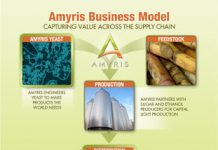Super-cali-thali-terpa-butyl-peta what?
Jim Lane
 The new trend in biofuels is not a biofuel at all – it’s an (usually unpronounceable) intermediate that can be refined into an array of fuels, chemicals, flavors, fragrances, and construction or packaging materials.
The new trend in biofuels is not a biofuel at all – it’s an (usually unpronounceable) intermediate that can be refined into an array of fuels, chemicals, flavors, fragrances, and construction or packaging materials.
Ptera-buta-thalic-what? We can hardly pronounce them, but we sure need to know about them.
Amyris (AMRS), KiOR (KIOR), Renmatix, Virdia, Blue Sugars, Proterro, Sucre Source, Sweetwater Energy, Genomatica – hot companies all, what do they have in common? Instead of making a finished end-product, they make an intermediate which is then upgraded to a finished product, typically by partners.
The range of intermediates is broad.
The hottest category is renewable sugars, which has attracted companies like Virdia, Blue Sugars, Proterro, Renmatix and Sweetwater Energy. Their challenge? Produce low-cost, high-performance renewable sugars that can be sold to synthetic biology companies like LS9, Virent, or Gevo (GEVO), who convert sugars into an array of useful end products ranging from surfactant alcohols, base chemicals like isobutanol, or diesel, jet or alcohol fuels.
Over at Amyris, they are producing biofene – essentially a known molecule that is too expensive to produce using conventional methods, and which they are marketing to partners as an excellent intermediate that can be used in the production of, for example, lubricants.
Over at KiOR, they are producing biocrude, using a pyrolysis process and Southern yellow pine as a feedstock. Their product, in turn, is sold to conventional oil refineries, that can upgrade that product, using fully conventional refinery processes, into a finished drop-in fuel.
At Genomatica, right now they are focused on a biobased BDO, or 1,4 butanediol, used as an intermediate in a host of products ranging from spandex fibers to solvents and printing inks.
One’s intermediate is another’s end-use product
Part of the reason for the trend has been the proliferation of biofuels strategy involving complex end-products, that are traditionally made from intermediates.
Take plastic bottles, for example. That’s PET, or poly(ethylene terephthalate).
(Try saying that three times real fast, and write me after you’ve figured out how to pronounce the “(” because poly(ethylene terephthalate) doesn’t really have any polyethylene in it. Sheesh.)
To make PET, you need monoethylene glycol, which is being made renewably around the world today. But you also need purified terephthalic acid (PTA), and to make that you need paraxylene. Until now, no one has figured out a way to make paraxylene, renewably and affordably – until Coke recently invested in Virent and Gevo, that are developing ways to do it.
In Gevo’s case, they are converting their biobased isobutanol to PX. Now, that isobutanol can also be used in its original form in green chemistry. Or, it can be burned in an internal combustion engine as a fuel molecule.
So you see, end products can be intermediates. And hopelessly confusing to the general interest reader at exactly the same moment that they are potentially transforming the way products are made that general interest readers use in everyday life.
Why intermediates, why now?
Intermediates have become a fashionable strategy for a couple of reasons.
One, the aforementioned complexity of renewable chemistry makes for a lot of intermediate demand in the everyday world of Big Chemicals.
Two, as companies like LS9 and Virent head for scale, they can use renewable sugar intermediates in place of, say, expensive corn syrup.
Three, feedstock companies can participate in the biobased economy without having to pick winners among the host of competing molecules. They don’t need to choose between ethanol, triglycerides, isobutanol, n-butanol, yada, yada, yada. They can make a renewable sugar, and sell it to a host of customers that make end products.
Is that why investing in intermediates companies is becoming more and more popular?
That’s a driving reason. Another is that the intermediate companies are getting better at what they do, and more of them are popping up. Take for instance, Waste Management (WM), which is now getting deeply involved with Renmatix and renewable sugars. That way, they don’t really have to worry as much about, for example, the fate of the Renewable Fuel Standard in their investment decisions. Because not all the customers are going to be making qualifying fuels.
Wait a minute – aren’t all fuel companies really just intermediate companies too, because can’t you make products like ethylene from ethanol?
Well, yep you can, if you have an affordable way to make that conversion, such as Dow has. Or ExxonMobil’s methanol-to-gasoline (MTG) process – and so on. You’ll find that a lot of the companies that are making cellulosic ethanol can make a lot of other products, too – they have focused on ethanol precisely because of the RFS, and because the vast demand for fuels creates assurances for investors that there will be a ready market for the product that is far more difficult to saturate than, for example, the market for succinic acid.
Speaking of succinic acid, isn’t it a big part of the strategy at companies like BioAmber and Myriant that they will be able to use their biosuccinic acid as an intermediate for other products?
Yep. In fact, BioAmber has licensed DuPont hydrogenation catalyst to make biobased 1,4 BDO from succinic acid. And from there, they can get into the same kind of markets that Genomatica is looking at with its direct-to-BDO process.
But aren’t intermediates really a story for biobased chemistry, rather than fuels?
Not at all. In fact, intermediates are a part of the story, to come extent, in the entire story of biofuels. With the exception of the 100% hydrous ethanol market in Brazil, all biofuels today are used in blends – and to an extent, blend ingredients are intermediates, although generally by intermediate we mean a product that will be further refined, rather than blended.
More than that, KiOR’s strategy is a sign of the times. Making affordable biocrude, and partnering with refineries to make finished fuels and chemicals from that point – why, that’s one way to make a the refining industry into happy supporters of instruments like the Renewable Fuel Standard. Remember, they generally oppose the RFS not because they think its bad for the planet, but because its bad for the refining business by cutting into their production volumes and creating all kinds of infrastructure demands on them at the same time. By contrast, they don’t really give a fig where your crude oil comes from – bio or fossil, they’ll happily take it all, if in-spec, and available at affordable prices and with .
Why hasn’t this been done all along the way? What are some of the down sides of intermediates?
A big issue is stability.
Biofuels are a little like wine and champagne – their chemistry can continue to evolve, and in 6 months after sitting in a tank, what you may not have is the same in-spec material you started with. (That’s why, for example, champagne pops when you pull out the cork – it has been fermenting in the bottle and that releases CO2, which is what causes the pressure build-up).
Some molecules attract water, some oxidize. With renewable sugars, there are fears that bacteria will have a
field day and gobble up the product if you try and transport renewable sugars via a pipeline – and who knows what you’ll end up with at the other end.
Are intermediates inevitable? Is the integrated model dead?
Hardly. Solazyme (SZYM) is an outlier in this case, and happily so. They aim to make some intermediates – for example, they make an intermediate oil which is hydroprocessed with partners to make Solajet aviation fuels. They also will make ingredients – such as Whole Algalin Flour, that they are making in partnership with Roquette and which will be used in a whole range of food products.
But they are also making finished end products for customers – take for example, their partnership with Dow to make dielectric fluids, which are used in those big power transformers all over the world. They are also, for example, not only making end-use products, but selling them directly on the Home Shopping Network, as in the case of their Algenist line of skin care products.
And take Avantium’s PEF product line, for example. Avantium’s YXY (“icksy”) technology can produce PEF, or polyethylene furanoate, and they believe that can replace traditional clear plastic (PET) altogether. No need, ahem, to produce PX to get to PTA so you can add MEG and get PET.
Or take companies like Mascoma, for example – they see transformational economics in consolidated bioprocessing – extracting sugars and fermenting into products, all at the one time. But they, themselves, might very well be exploring the making of intermediates from their process, even if they are not a big customer for them.
The bottom line
Intermediates are a big trend.
Feedstock players like the optionality it gives them.
Processing technologies like the flexibility of buying intermediates from a host of suppliers, or the option to produce intermediates as well as end-products, in optimizing their production economics.
End-use customers – well, they don’t care except to the extent that they get parity-or-better performance and parity-or-better cost. But, of course, those are the very qualities that optionality are likely to give them.
Disclosure: None.
Jim Lane is editor and publisher of Biofuels Digest where this article was originally published. Biofuels Digest is the most widely read Biofuels daily read by 14,000+ organizations. Subscribe here.








